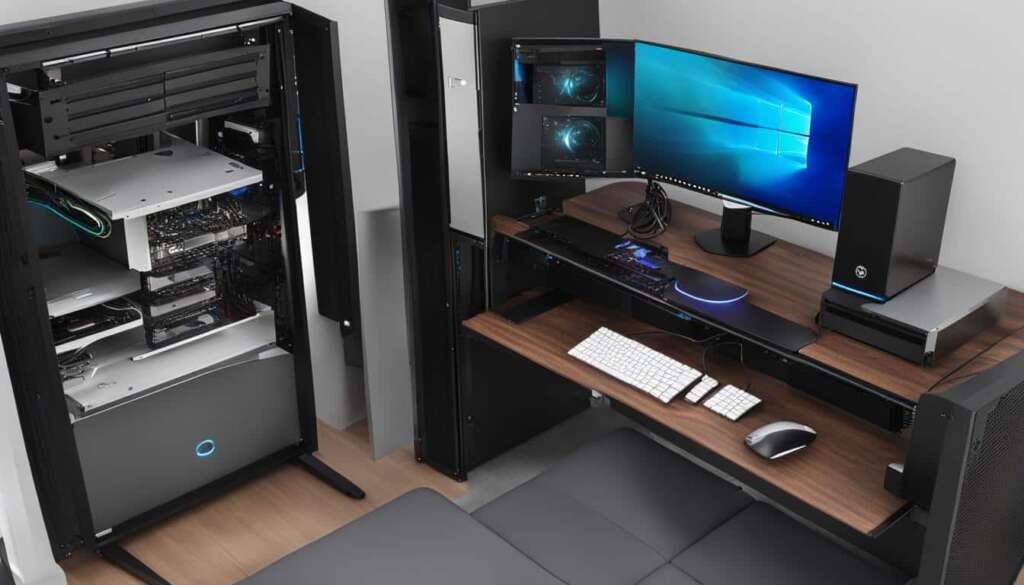Table of Contents
Scanning documents from your Canon printer to your computer is simple. Just follow Canon’s step-by-step guide to scan and save documents on your PC.
The Canon printer lets you pick from three scan settings: Color, Black and White, Custom 1 (Color), and Custom 2 (Color)1. Each setting scans at 300 dpi for the best image quality1.
You can choose from various file formats like PDF, TIFF, and JPEG/Exif for your scanned documents1. Saving in PDF format makes it easy to search the text within the documents1.
Start scanning either through a USB or network connection, so you can scan from different devices easily1. Choosing black and white scanning will skip the shades of gray1.
Your scanned files automatically go into the [Pictures] or [My Pictures] folder, in a subfolder named by the scan date1. The printer’s PC1 and PC2 buttons help you save different scan settings and destinations1.
To send documents to your PC, pick your computer as the save spot, select the scan color, and start scanning. Your documents will be saved in the chosen folder on your PC1.
Key Takeaways:
- Canon printers give you a choice of scan settings and resolutions for your needs1.
- You can pick from different file formats and search text in PDF documents easily1.
- With USB or network connections, scanning is flexible and accessible1.
- Save your scanning settings on the printer for quick future scans1.
- Follow Canon’s instructions for a smooth scanning process1.
How to Scan from a Canon Printer to PC
To scan documents from your Canon printer to your PC, follow these easy steps:
- Ensure that your Canon printer has scanning capabilities. All-in-one models are capable of scanning, and some other printer models may also offer this functionality2.
- Connect your Canon printer to your PC either wirelessly via a touch-screen panel or through a USB cable2.
- Install the necessary printer drivers and utilities, including the IJ Scan Utility, which is required for scanning. Drivers can be installed from a CD/DVD or downloaded from the Canon website2.
- Place the document you want to scan face-down in the scanner, aligning it with the specific markers or guides depending on the model2.
- Open the IJ Scan Utility on your PC and select the desired document settings, such as resolution and color format. Choose the save destination for the scanned document2.
- Initiate the scan process by clicking the “Scan” button. The document will be scanned into your PC, and multiple pages can be scanned successively2.
- Remember to adjust document options like resolution and color format to achieve the desired scan quality. These settings can affect the appearance of the scanned document2.
- Once the scan is complete, the scanned documents are typically saved in designated folders within your PC, such as the “Documents” folder or a location of your choice2.
While Canon printers are great for scanning, some items may not scan well. These include A4 sized photos, small documents, originals on thin white paper, and long narrow photos3.
By following these steps, you can easily scan documents from your Canon printer to your PC. This makes it simple to keep your documents organised and easy to find.
Setting Up Scanning on a Canon Printer
To get your Canon printer ready for scanning to your PC, there are a few steps to follow. These steps will help you set up your printer for scanning. This way, your machine will be connected to your computer ready for scanning.
First, make sure your Canon printer is initially set up and drivers are installed. After that, you can move on to the next steps:
- Check the network scan settings on your Canon printer. This makes sure the scan feature works well with your PC4.
- Launch the Canon IJ Scan Utility on your computer. It provides the tools needed for scanning from your printer4.
- In the utility, set where to save your scans and how to name them. This helps you find your scanned documents easily4.
- Pick your PC as the place to send scans. The utility will show simple steps to connect your printer to the computer4.
- Put the document you want to scan on the printer glass or feeder. You can also choose color settings for the scan4.
- Select a file format like JPEG, TIFF, PDF, or Compact PDF for your scans. This depends on what you need4.
- After scanning, you can scan more documents or end the process. The utility will guide you on what to do next4.
- Take your document off the printer when done to keep it safe4.
- A program selection screen might show up after scanning. Here, you can choose an app to view your scanned documents4.
- You can also use OCR (Optical Character Recognition) technology. It allows you to edit text from your scanned images4.
By doing these steps and using what the Canon IJ Scan Utility offers, setting up scanning on your Canon printer becomes simple. It lets you easily scan documents or photos to your computer. With your Canon printer, scanning different types of documents or preserving photos is convenient.
Advanced Scanning Options on a Canon Printer
If you want to improve your scanning, Canon printers have many advanced settings. These can make your scanning better. Whether it’s adjusting settings, scanning lots of pages, or making your scans perfect for a purpose, Canon printers can do it.
Adjusting Scan Settings
Canon printers let you change your scan settings in detail. You can tweak things like resolution and color. This means your scans will capture every little detail perfectly.
Scanning Multiple Pages
Scanning many pages with a Canon printer is easy. You can use the automatic document feeder or the glass to scan lots of pages quickly. It saves you time and makes scanning big documents simple.
OCR (Text Searchable) PDF Files
Canon printers can make OCR PDF files from two-sided papers. This is great for when you need to search documents digitally. It makes finding things in your documents much faster, boosting your work productivity.
Using advanced features on Canon printers brings benefits, says data from PC Site5. Turning papers into PDFs saves space and makes searching easier. It can also cut down on printing costs. Password protecting your scans keeps your information safe.
Canon printers work with different operating systems too. Data from PC Site5 shows how to share folders on Windows or create them on Macs. This means Canon scanning works well with many computers.
Canon printers have lots of advanced options to improve your scanning. They let you adjust, scan many pages, or make OCR PDFs. With these tools, your scanning results will be great.
Conclusion
Scanning documents from a Canon printer to your PC is both easy and quick. Canon provides clear instructions for this. You can scan and save documents to your computer in just a few clicks.
Whether you’re scanning a single page or many, or need to tweak more complex settings, the Canon printer is up to the task. It turns your paper documents into digital format with ease and efficiency.
Embrace the ease of digital storage and say farewell to physical clutter. The Canon printer doesn’t just scan quickly but also ensures the images are of top quality. Following Canon’s straightforward steps to scan documents means you get to enjoy the perks of digital filing without hassle.
Follow this link to find out how to connect your Canon printer to your laptop. Explore all the features and functionalities that Canon printers offer.
FAQ
How do I scan from a Canon printer to my PC?
To scan from a Canon printer to your PC, just follow Canon’s easy instructions. First, select your computer as where you want to save the scan. Choose how you want the scan to look and start. Once it’s done, the file will be on your PC in the folder you chose.
What setup steps are involved in scanning from a Canon printer to my PC?
Before scanning to your PC from a Canon printer, you need to do a bit of setup. Make sure your printer and computer are talking to each other. Then, pick where you want to save your scans. You can also tweak settings to get your scans just right.
Can I customize my scanning experience on a Canon printer?
Yes, customizing your scans on a Canon printer is easy. You can play around with lots of advanced features. Change the resolution, file type, and even fix the images to make them perfect for what you need.
How easy is it to scan and save documents to my computer using a Canon printer?
Scanning to your PC with a Canon printer is pretty simple. Canon’s instructions are clear and easy to follow. You can scan anything from a single page to stacks of documents. And, you can adjust the settings to fit what you’re scanning, making it a great tool for any project.
What are the benefits of scanning documents to a computer using a Canon printer?
Scanning with a Canon printer has lots of pluses. It turns piles of papers into digital files, clearing up space. It’s easier to find, tidy, and share files too. In the end, scanning helps you work smarter and faster.
Source Links
- https://oip.manual.canon/USRMA-0025-zz-SS-enUV/contents/07020010.html – Scanning Using the PC> Button
- https://www.wikihow.com/Scan-a-Document-on-a-Canon-Printer – How to Scan a Document on a Canon Printer (with Pictures)
- https://support.usa.canon.com/kb/index?page=content&id=ART142078 – Canon Knowledge Base – Scan to a Windows Computer
- https://support.usa.canon.com/kb/index?page=content&id=ART116910 – Canon Knowledge Base – How to Scan to a Windows Computer Using the Machine’s operation Panel
- https://oip.manual.canon/USRMA-0134-zz-CS-enUV/contents/CS4251_practical564_scanningtheoriginalandsendingtoacomputer.html – Scanning the Original and Sending to a Computer








